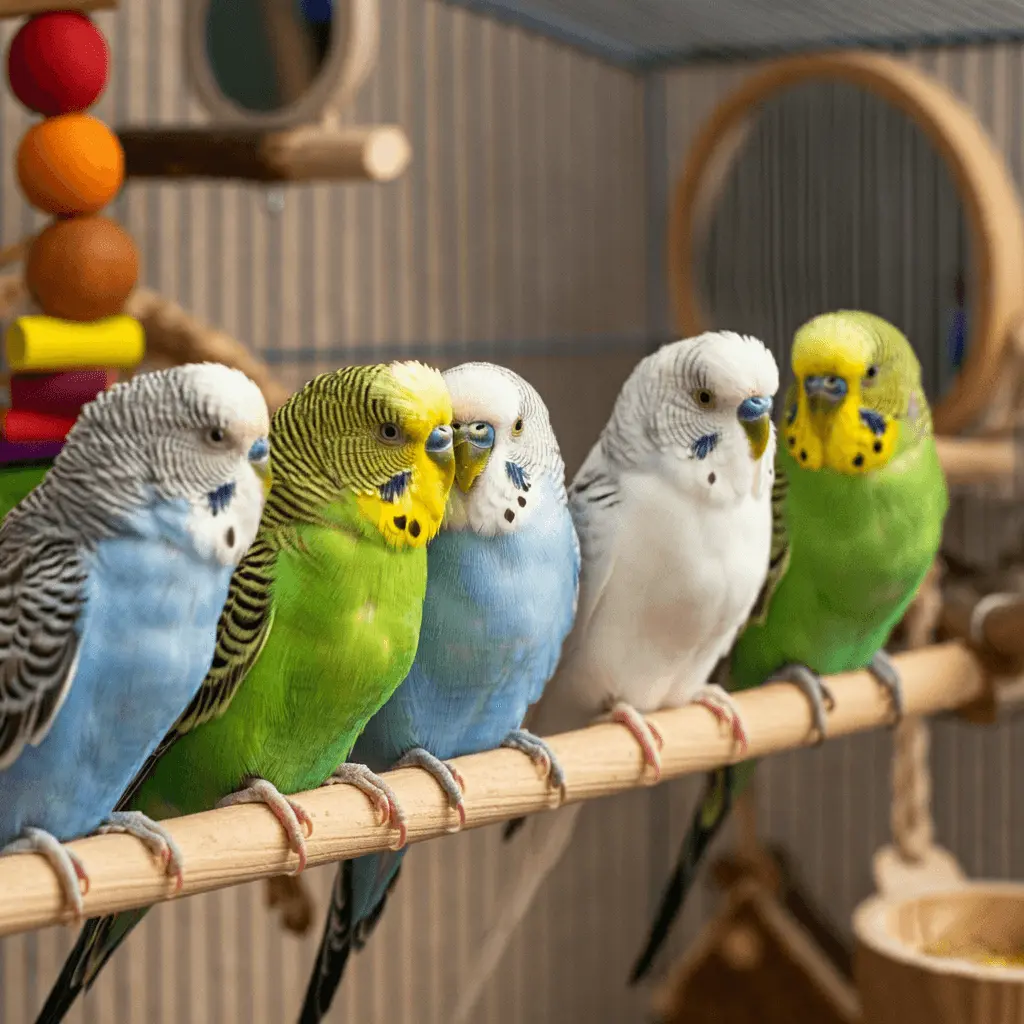Introduction
Introducing a new budgerigar to your existing flock can be an exciting yet delicate process. Whether you’re adding a single budgie or several, it’s important to do it right to ensure a smooth transition and harmony in your flock. Budgies are social creatures, but they can also be territorial, so understanding the best way to introduce them to each other is key to avoiding conflicts and ensuring that they bond well.
In this guide, we’ll walk you through the step-by-step process of how to introduce new budgerigars to your flock safely and effectively. From quarantine steps for your new budgie to tips on how to stop budgies from fighting, we’ve got you covered. We’ll also explore how to gradually integrate your new budgie into the flock without causing stress to your existing birds. By following these simple yet effective strategies, you can help your budgies get along and create a peaceful, happy environment for all.
Whether you’re a seasoned budgie owner or a first-time bird parent, this guide will provide valuable insights to make the introduction process as smooth as possible. After all, the goal is to create a thriving, well-integrated flock where every budgie feels safe and secure.
Why Proper Introduction Matters
Properly introducing new budgerigars to your flock is crucial for maintaining peace and harmony among your birds. Budgies are naturally social, but they are also territorial, which means that bringing a new budgie into an established group can be tricky. Without a careful introduction, the existing budgies might see the newcomer as a threat, leading to stress, aggression, and even fights.
When you introduce a new budgie correctly, you give all your birds the best chance to bond and form a cohesive flock. A smooth introduction process not only minimizes the risk of conflict but also helps your new budgie feel safe and welcome in its new environment. It’s not just about avoiding budgie fights; it’s about fostering positive interactions and encouraging a healthy social dynamic among all your birds.
Taking the time to follow the proper steps—like quarantine, gradual introduction, and supervised interactions—can make all the difference. This careful approach helps prevent health issues and ensures that your budgies can coexist peacefully. Remember, a well-integrated flock is happier, healthier, and more likely to thrive together. That’s why understanding how to introduce new budgerigars to your flock is so important for every budgie owner.
Preparing for the Introduction
Before you introduce a new budgerigar to your flock, preparation is key. Proper planning ensures that the introduction goes smoothly and reduces the chances of any issues arising. Here’s what you need to do to get ready.
Choosing the Right Time
Timing is everything when it comes to introducing new budgies. Make sure your existing flock is healthy and calm before bringing in a newcomer. If your birds are stressed, molting, or recovering from illness, it’s best to wait until they’re in a better state. A stable environment makes the introduction less stressful for everyone involved.
Setting Up a Quarantine Area
One of the most important steps in preparing for the introduction is setting up a quarantine area for your new budgie. Quarantine isn’t just a precaution; it’s essential to prevent the spread of potential illnesses. Keep the new bird in a separate cage, away from your existing flock, for at least 30 days. This gives you time to observe the new budgie for any signs of illness and ensures that it’s healthy before meeting the other birds.
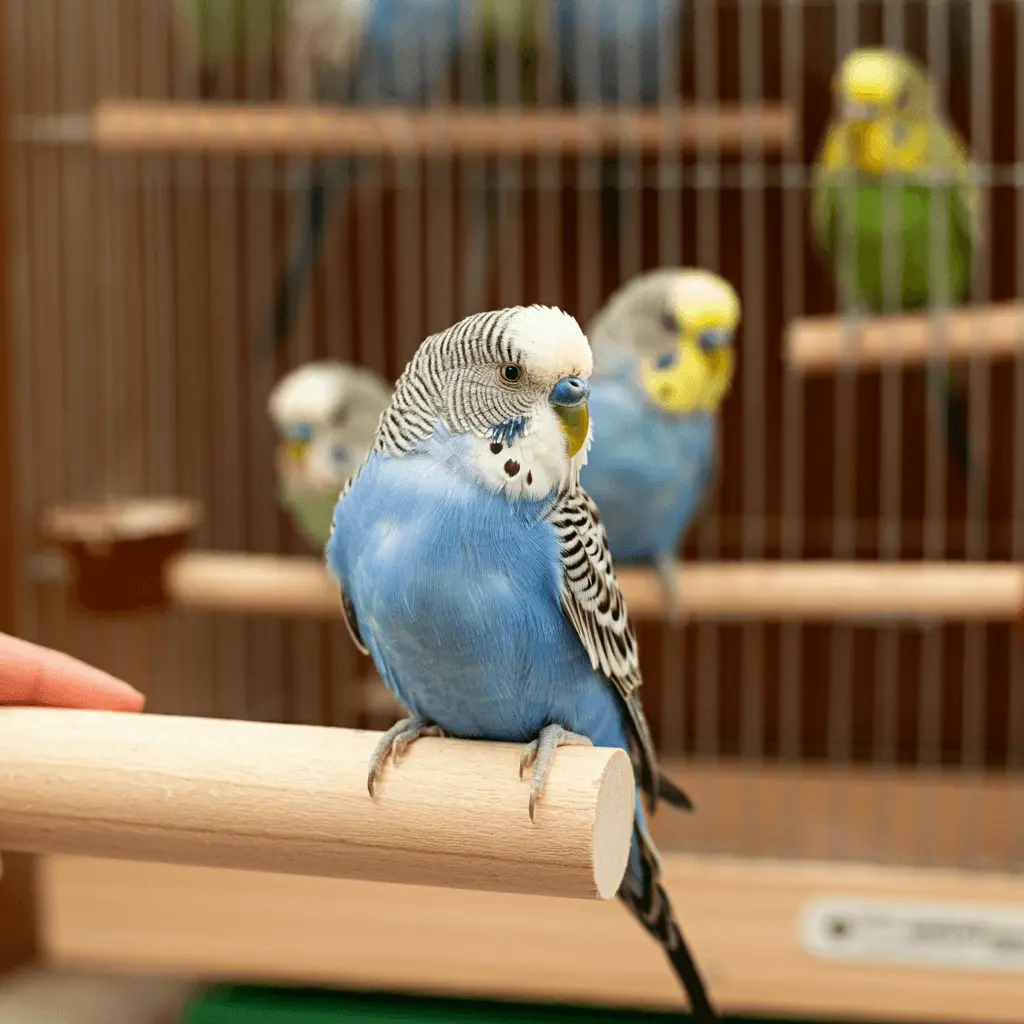
A blue budgie sits in a quarantine cage, essential for the initial introduction to a new flock to ensure the health of all birds.
Ensuring Health and Safety
During the quarantine period, take your new budgie for a vet check-up to confirm that it’s healthy and free of any contagious diseases. It’s also a good time to gradually introduce the new bird to the diet you feed your existing flock, which can help with the transition later on. Ensure that both the new budgie’s cage and the existing flock’s environment are clean, well-maintained, and stress-free.
By carefully preparing for the introduction, you set the stage for a successful integration. These steps may seem simple, but they are vital in ensuring that your budgerigars can meet each other without unnecessary stress or risk. With the right preparation, you can help your new and existing budgies build a positive relationship right from the start.
Step-by-Step Guide to Introducing New Budgerigars to Your Flock
Introducing a new budgerigar to your flock is a delicate process that requires patience and careful observation. Here’s a step-by-step guide to help you ensure that the integration is smooth and stress-free for all your birds.
Step 1: Allowing the Birds to See Each Other
Start by placing the new budgie’s cage near the existing flock’s cage, but not so close that they can physically interact. This allows them to see and hear each other without direct contact. Over the course of a few days, you’ll notice them getting curious about one another. This visual introduction helps them get accustomed to each other’s presence without the risk of immediate conflict.
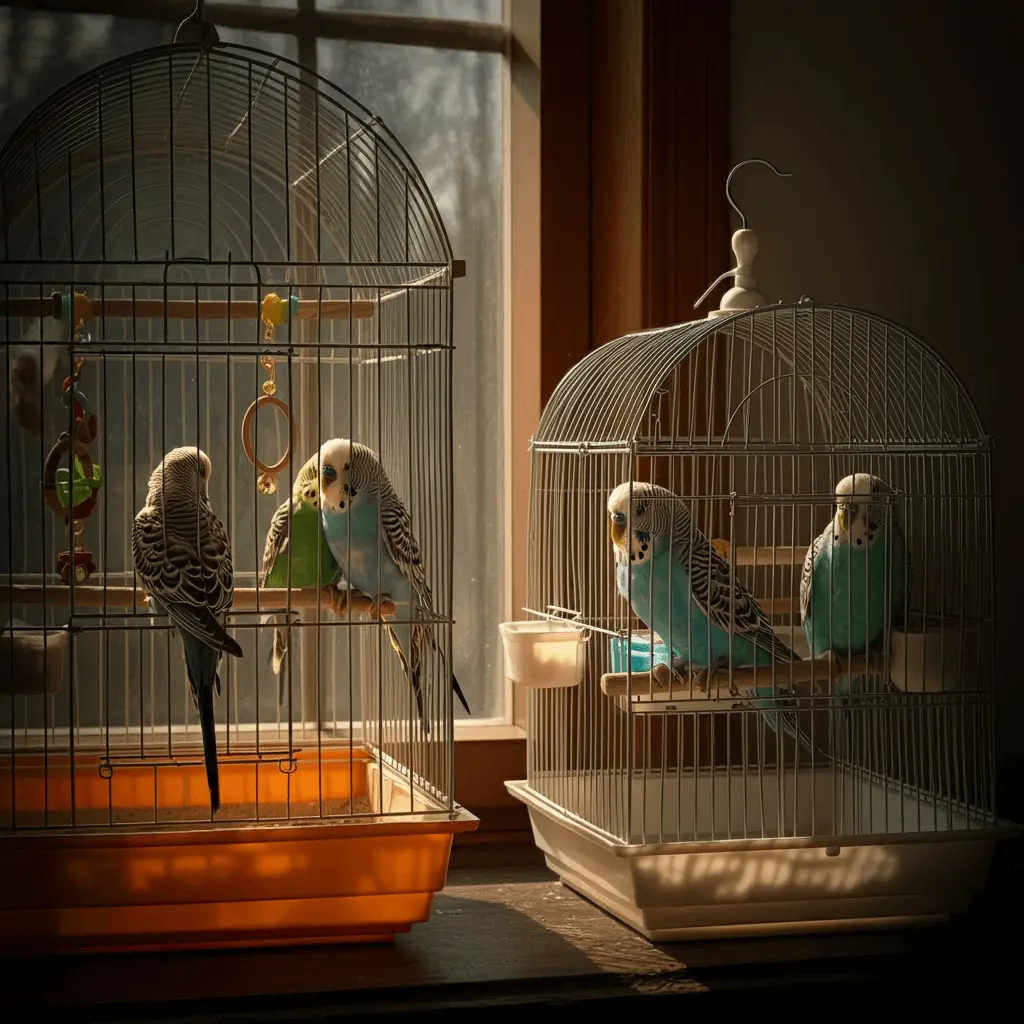
Two budgies housed in separate cages to gradually introduce them to each other, minimizing aggression and stress.
Step 2: Gradually Increasing Interaction
After a few days of visual introduction, it’s time to let the budgies interact more closely. You can start by allowing them to explore a shared space outside of their cages, such as a neutral play area. This environment should be unfamiliar to all birds to minimize territorial behavior. Keep these interactions short at first, gradually increasing the time they spend together as they become more comfortable.
Step 3: Monitoring Body Language and Behavior
Pay close attention to the body language of both the new budgie and your existing flock during these initial interactions. Signs of aggression, such as raised feathers, loud squawking, or pecking, should be addressed immediately by separating the birds. Positive signs, like mutual grooming or calm behavior, indicate that the birds are starting to accept each other.
Step 4: Supervised Group Time
As the budgies become more familiar with each other, you can allow them to spend more time together under close supervision. At this stage, it’s important to keep an eye on their interactions to prevent any potential conflicts. If all goes well, you’ll see the birds beginning to bond, sharing perches, or even preening each other. These are signs that the integration is progressing successfully.
Step 5: Final Integration
Once the budgies have shown consistent positive behavior towards each other, you can consider moving the new budgie into the main cage with the existing flock. Make sure the cage has plenty of space, perches, and food dishes to minimize competition. Continue to monitor their interactions closely for the first few days. If any issues arise, don’t hesitate to separate them and revisit the earlier steps.
Introducing new budgerigars to your flock requires time, patience, and careful observation. By following these steps, you can help ensure that your birds build a positive relationship and create a peaceful, happy flock.
Common Challenges and How to Overcome Them
Introducing new budgerigars to your flock isn’t always straightforward, and challenges can arise during the process. Understanding these common challenges and knowing how to overcome them will help you manage the introduction smoothly and ensure a harmonious flock.
Challenge 1: Aggression Between Budgies
One of the most common challenges when introducing new budgerigars is aggression. Existing budgies might see the newcomer as an intruder, leading to territorial behavior such as chasing, pecking, or loud squawking. To overcome this, ensure that you follow the gradual introduction process. Start with visual introductions and gradually increase interaction time. If aggression occurs, separate the birds immediately and give them more time to adjust to each other’s presence before trying again.
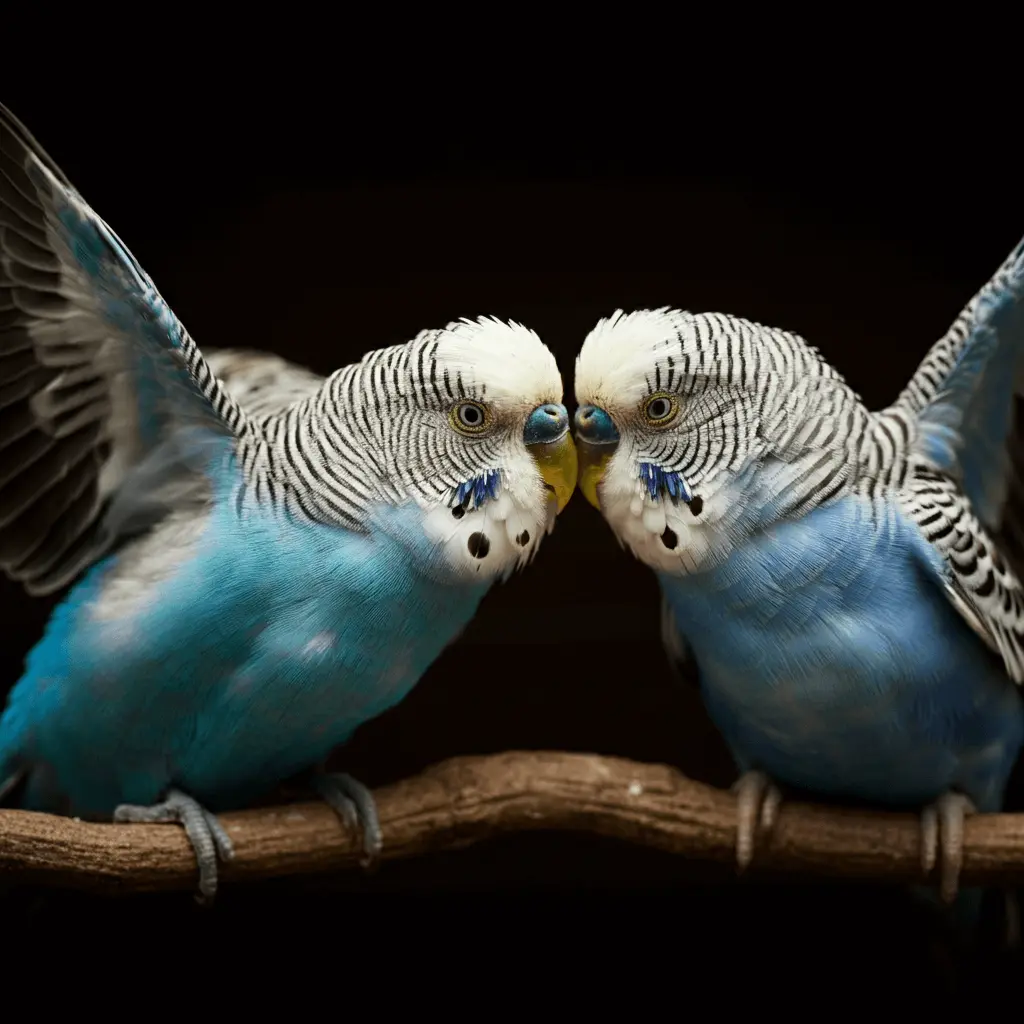
A pair of budgies exhibit aggressive behavior, highlighting the challenges that can arise when introducing new birds to a flock.
Challenge 2: Stress in the New Budgie
A new environment can be overwhelming for a budgie, leading to stress. Signs of stress include excessive chirping, feather plucking, or a lack of appetite. To help your new budgie adjust, make sure it has a quiet, safe space during the quarantine period. Gradually introduce the bird to its new surroundings and flock, allowing it to acclimate at its own pace. Providing familiar toys and a consistent routine can also help reduce stress.
Challenge 3: Resistance to Bonding
Sometimes, existing budgies may resist bonding with the new bird, ignoring or avoiding it altogether. If this happens, don’t rush the process. Continue to provide opportunities for interaction in neutral spaces, and try offering shared treats or toys to encourage bonding. Patience is key here—some budgies may take longer to warm up to a new companion, and that’s perfectly normal.
Challenge 4: Space and Resource Competition
Limited space and resources can lead to competition and conflict within your flock. If your budgies are fighting over perches, food dishes, or toys, it’s important to provide ample space and multiple resources. Ensure that your cage is spacious enough for all birds and that there are enough perches and feeding areas to reduce competition. This simple adjustment can go a long way in preventing disputes.
Challenge 5: Uneven Social Dynamics
In some cases, introducing a new budgie can disrupt the social dynamics of your flock, leading to an imbalance where some birds may feel left out. To address this, observe the interactions closely and make adjustments as needed. You may need to separate birds temporarily or change the cage setup to create a more balanced environment.
By anticipating these common challenges and taking proactive steps to address them, you can help ensure that the introduction of a new budgerigar to your flock is as smooth and stress-free as possible. Remember, every flock is unique, and some challenges may require patience and creativity to overcome, but with the right approach, your budgies can learn to coexist happily.
Tips for a Smooth Transition
Successfully introducing a new budgerigar to your flock requires more than just following the steps—it’s about creating an environment where all your birds can thrive together. Here are some practical tips to ensure a smooth transition and a harmonious flock.
Tip 1: Take Your Time
One of the most important tips for introducing new budgerigars to your flock is to take your time. Rushing the process can lead to stress and conflict. Allow each stage of the introduction—from quarantine to final integration—to unfold naturally. Pay attention to the cues your budgies give you, and don’t move on to the next step until all birds are comfortable.
Tip 2: Provide Plenty of Space
Space is crucial when integrating a new budgie into your flock. A spacious cage allows each bird to have its own territory, reducing the likelihood of territorial disputes. If possible, upgrade to a larger cage or add more perches and toys to the existing one. This gives your budgies the freedom to explore and interact on their own terms.
Tip 3: Use Positive Reinforcement
Positive reinforcement can be a powerful tool during the introduction process. Rewarding your budgies with treats when they interact calmly or positively helps reinforce good behavior. This not only encourages bonding but also makes the experience enjoyable for the birds.
Tip 4: Monitor Interactions Closely
Even after your budgies have been introduced, it’s important to monitor their interactions closely. Keep an eye out for any signs of aggression, stress, or exclusion. Early intervention can prevent minor issues from escalating into bigger problems. If you notice any concerning behavior, don’t hesitate to separate the birds and give them more time apart before reintroducing them.
Tip 5: Maintain a Routine
Budgies thrive on routine, so maintaining a consistent daily schedule can help ease the transition for both new and existing birds. Feed them at the same times each day, provide regular playtime, and ensure their environment is stable. A familiar routine helps reduce stress and makes the introduction process smoother.
Tip 6: Be Patient and Flexible
Every budgie and every flock is different, so it’s important to be patient and flexible during the introduction process. Some birds may take longer to adjust, while others might bond quickly. Be prepared to adapt your approach based on the unique dynamics of your flock. Flexibility and patience are key to ensuring a successful integration.
By following these tips, you can create a positive, stress-free environment that encourages your budgerigars to bond and thrive together. A smooth transition sets the foundation for a happy, well-integrated flock that will bring joy to both you and your birds for years to come.
Signs of Successful Integration
Once you’ve introduced your new budgerigar to the flock, it’s important to know the signs of a successful integration. These signs indicate that your birds are getting along well and have accepted each other as part of the same group. Here’s what to look for:
Sign 1: Mutual Grooming
One of the clearest signs that your budgerigars have successfully integrated is mutual grooming, also known as preening. When budgies preen each other, it’s a sign of trust and bonding. If you see your new and existing budgies gently grooming one another, it’s a strong indicator that they’ve accepted each other and are forming a close bond.
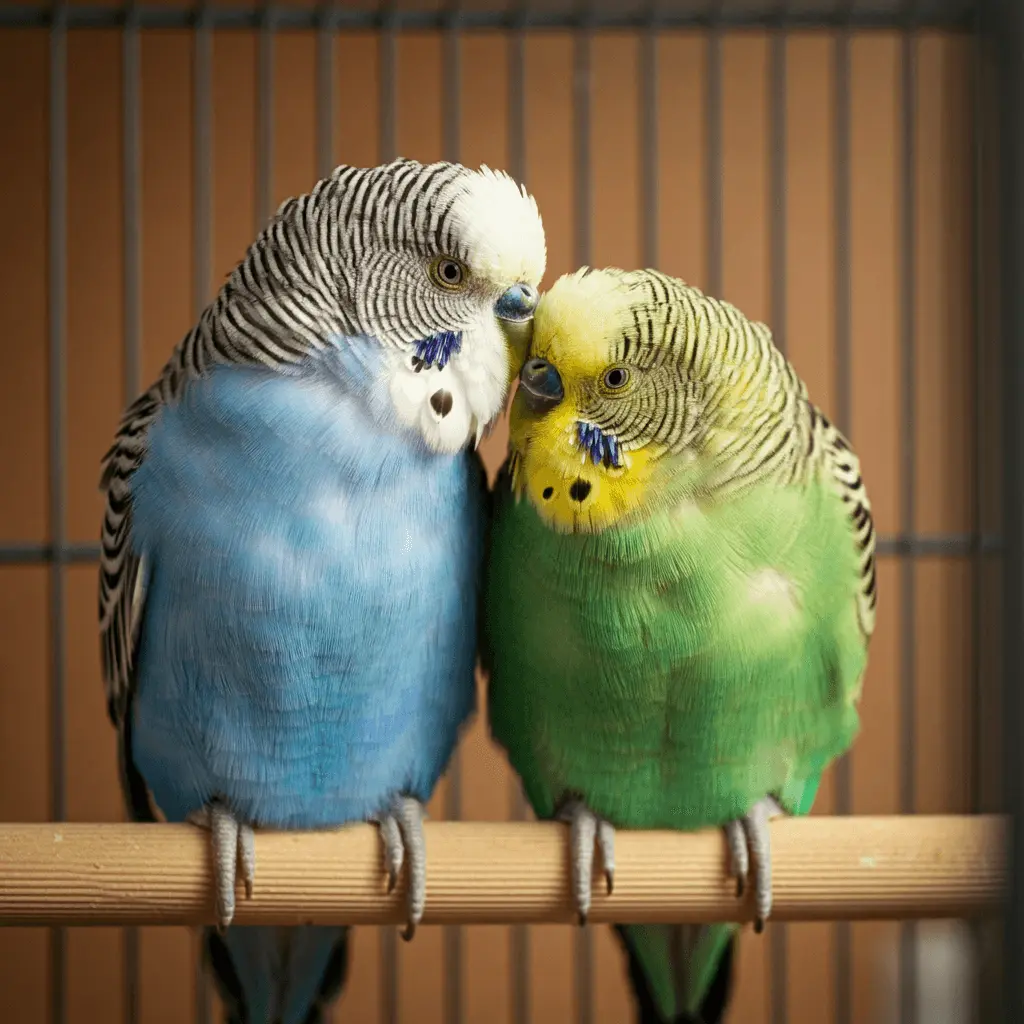
Two budgies engage in mutual grooming, a sign of a strong bond and successful introduction into the flock.
Sign 2: Shared Perches and Food Dishes
Budgies that have successfully integrated will comfortably share perches and food dishes without any signs of aggression or territorial behavior. If your new budgie is able to perch next to the others without any issues and eat alongside them, it shows that the birds are at ease with each other and have established a peaceful coexistence.
Sign 3: Playful Interaction
Playful interaction is another positive sign of successful integration. Budgies that are comfortable with each other will engage in playful behaviors, such as chasing, hopping from perch to perch together, or playing with toys side by side. These interactions indicate that the birds are enjoying each other’s company and are building a strong social bond.
Sign 4: Calm and Relaxed Behavior
A well-integrated flock will display calm and relaxed behavior. You’ll notice your budgies resting peacefully together, with no signs of stress, fear, or aggression. If your new budgie is relaxed and behaves similarly to the existing flock, it’s a sign that the integration has gone smoothly and that all the birds feel secure in their environment.
Sign 5: Vocal Communication
Budgies that have successfully integrated will often engage in vocal communication with each other. This includes chirping, singing, and mimicking each other’s sounds. Vocal interaction is a sign of a strong social bond and indicates that the birds are comfortable and happy in each other’s presence.
Recognizing these signs of successful integration is crucial for ensuring the long-term harmony of your flock. If you observe these behaviors, it means your budgerigars have accepted the new member and are living together peacefully. However, if you notice any signs of ongoing tension or aggression, it may be necessary to revisit some of the earlier steps in the introduction process. With patience and attention, you can help your budgies build a lasting and positive relationship.
FAQs About Introducing New Budgerigars to Your Flock
Introducing new budgerigars to your flock can raise many questions, especially if you’re new to the process. Below are some frequently asked questions to help guide you through a successful introduction.
How long should I keep my new budgie in quarantine?
It’s recommended to keep your new budgie in quarantine for at least 30 days. This period allows you to monitor the new bird for any signs of illness and ensures that it’s healthy before introducing it to your existing flock. Quarantine is crucial for preventing the spread of disease and keeping all your birds safe.
What if my budgies don’t get along after the introduction?
It’s not uncommon for budgies to take time to adjust to each other. If your birds show signs of aggression, such as chasing or pecking, separate them and allow more time for gradual reintroduction. You can try placing their cages near each other so they can see and hear each other without direct contact. Patience and a slow, steady approach often lead to better results.
Can I introduce more than one new budgie at the same time?
Yes, you can introduce more than one new budgie at the same time, but it’s important to follow the same gradual introduction process. Quarantine each new bird separately, and then introduce them to your existing flock one at a time. This helps prevent overwhelming your current birds and reduces the risk of conflict.
What should I do if my new budgie is stressed during the introduction?
If your new budgie shows signs of stress, such as excessive chirping, feather plucking, or a lack of appetite, give it more time to adjust. Ensure that it has a quiet, safe space and a consistent routine. Gradually increase its interaction with the other birds, and make sure to provide plenty of toys and perches to keep it entertained.
How can I tell if my budgies are successfully integrated?
Signs of successful integration include mutual grooming, shared perches, playful interaction, and calm behavior. If your new budgie is accepted into the flock without any signs of aggression or stress, it means the integration has been successful. Keep monitoring their behavior to ensure ongoing harmony.
Is it normal for budgies to be noisy during the introduction?
Yes, it’s normal for budgies to be more vocal during the introduction period. They may chirp or call out to each other as they adjust to the new social dynamics. As long as there are no signs of aggression, this increased noise is usually just part of the process and should settle down as the birds become more comfortable with each other.
These FAQs cover the most common concerns about introducing new budgerigars to your flock. By understanding the process and knowing how to address potential challenges, you can ensure a smooth and successful integration for all your budgies.
Conclusion
Introducing new budgerigars to your flock is a process that requires careful planning, patience, and attention to detail. By following the step-by-step guide outlined in this post, you can ensure that the integration is smooth, stress-free, and successful. Remember, the key to a harmonious flock is taking the time to prepare, gradually introducing the birds, and being attentive to their behavior throughout the process.
Properly introducing new budgies not only helps prevent conflicts but also sets the stage for positive bonding and long-lasting relationships among your birds. Whether you’re adding a single budgie or more, the effort you put into this process will pay off in the form of a happy, well-integrated flock.
If you’ve followed these tips and guidelines, you’re well on your way to creating a peaceful and thriving environment for all your budgerigars. With time, you’ll see your new budgie becoming a cherished member of the flock, enjoying playful interactions and building strong bonds with its companions.
For any budgie owner, understanding how to introduce new budgerigars to your flock is an essential skill that ensures the health, happiness, and harmony of your birds. Take the time, be patient, and soon you’ll have a flock that’s not only peaceful but also full of life and joy.

